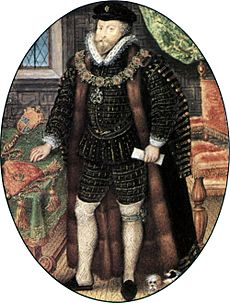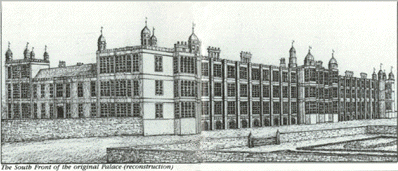Christopher Hatton facts for kids
Sir Christopher Hatton (born December 12, 1540 – died November 20, 1591) was an important English politician. He served as the Lord Chancellor of England and was a close friend and trusted advisor to Queen Elizabeth I. He was also involved in the trial that found Mary, Queen of Scots responsible for serious crimes against the Queen.
Contents
Sir Christopher Hatton's Early Life
Christopher Hatton was born in Holdenby, Northamptonshire. His father was William Hatton, and his mother was Alice Saunders. His family history was very old and well-known.
He had two brothers, Thomas and William, and a sister named Dorothy. His brothers seem to have died young. Dorothy's son, William Newport, later became Christopher Hatton's main heir.
Christopher Hatton's education was likely overseen by his uncle, William Saunders. When he was about 15 or 16, he went to St Mary Hall, Oxford university. He didn't finish his degree there. In 1560, he joined the Inner Temple, which was a place where people studied to become lawyers. It's not clear if he ever officially became a lawyer.
Hatton's Rise to Power
In 1561, Christopher Hatton took part in a special performance called a masque at the Inner Temple. During this event, he caught the eye of Queen Elizabeth. He was known for being handsome and a very good dancer. His dancing skills quickly made him a favorite of the Queen, who even nicknamed him "The Dancing Chancellor."
Becoming a Royal Favorite
By 1564, Hatton became one of the Queen's gentlemen pensioners, a special guard, and a gentleman of her private rooms. In 1572, he became the captain of the Queen's personal guards. In 1577, he was made vice-chamberlain of the royal household and joined the Privy Council, a group of the Queen's most important advisors. That same month, he was made a knight.
In 1578, the Queen gave him a house in London, despite protests from the Bishop of Ely who owned it.
Hatton's Role in Parliament
Hatton served as a Member of Parliament for Higham Ferrers in 1571. From 1572, he represented Northamptonshire. He was active in Parliament, especially in important legal cases.
In 1581, he was part of a group asked to arrange a marriage for the Queen with Francois, Duke of Alençon. However, Hatton advised the Queen not to go through with the marriage.
His loyalty to the Queen was very strong. In 1584, he led 400 members of the House of Commons in a prayer for the Queen's safety.

Hatton was also involved in the trial of Mary, Queen of Scots in 1586 and 1587. He was one of the officials who found her responsible for serious actions against the Queen. He strongly spoke against her in Parliament.
Queen Elizabeth often wore gifts from Hatton. Once, she wore a jewel shaped like bagpipes that he sent her. This was a playful reference to shepherds and her nickname for him, "her mutton."
Becoming Lord Chancellor
In 1587, Hatton became Lord Chancellor, a very high legal position. Even though he didn't have a lot of legal training, he was known for being fair and sensible in his decisions. He was also known for treating religious questions in a calm and accepting way.
Hatton was also the chancellor of the University of Oxford. He supported writers and artists, and the famous poet Edmund Spenser was one of his friends. Hatton even wrote part of a play called Tancred and Gismund.
Christopher Hatton never married. His large properties went to his nephew, Sir William Newport, who then took the name Hatton.
Hatton's Great Wealth
Christopher Hatton became very rich because of his successful career and the Queen's favor. In 1583, he started building a huge house called Holdenby in Northamptonshire. It was meant to be the biggest private home in England at the time.
The house had 123 large glass windows, which was a sign of extreme wealth because glass was very expensive back then. It was as big as Hampton Court palace and had two grand state rooms, one for himself and one for the Queen, though she never visited.
Even Lord Burghley, another important figure, was amazed by the house's grand staircase. Hatton spent so much money on Holdenby that he struggled with finances for the rest of his life.
To help with his money problems, Hatton invested in some of Francis Drake's sea voyages. During one of Drake's trips around the world, he renamed his ship The Golden Hind in honor of Hatton's family symbol, which was a golden deer. Hatton made a good profit from this expedition.
Hatton's Final Years
Despite his successes, Hatton died with many debts. His grand Holdenby mansion was finished in 1583, but he reportedly refused to sleep there until Queen Elizabeth I would visit. He also started building another country house, Kirby Hall, in 1570, which was designed in a grand, classical style.
Hatton's health got worse in 1591. The Queen visited him on November 11. He died nine days later at Ely Place in London. He was given a large state funeral at St Paul's Cathedral. A huge monument to him stood there until the Great Fire of London in 1666 destroyed it.
Commemorations
Today, Hatton Garden in London, famous for its diamond trade, is located on the site of Hatton's former home. Also, Sir Christopher Hatton Academy, a school, was founded in 1983 in Wellingborough, Northamptonshire.
See also
Images for kids




